Perennial lupine: description, varieties, planting and care

Perennial lupine is an unpretentious plant that is successfully used in agriculture, landscape design, and in making light summer bouquets. Summer residents and amateur flower growers especially appreciate it for its beautiful, bright inflorescences that can transform both a wild natural garden and a luxurious French-style park. This plant easily takes root on the site, allows for different methods of reproduction. Planting and leaving is also not a hassle and takes a minimum of time.

Perennial lupine can be a real discovery for those who want to find a brightly decorated corner of the garden or a stylish flower bed. The description of the varieties allows you to appreciate the color and decorative variety of this magnificent honey plant.
Peculiarities
Perennial lupine is a plant that naturally occurs in North America, in the Andes and Cordilleras, at an altitude of 4800 m, it takes root well in the Mediterranean climate, but also in the climate of the Russian central zone feels quite normal. In the places where they grow, these flowers play a very important role, providing the soil with nitrogen. Perennial lupine greens at the end of the flowering season can be used to make organic fertilizers.


The description of the plant indicates that it belongs to the legume family. Ripening seeds of these flowers are in miniature pod-pods. The plant has a straight, upward stem, lush, unusually cut leaves. On one bush, many shoots are formed, ending in cluster-like inflorescences. The perennial lupine has a thickened, fleshy rhizome, well adapted to nourish the plant throughout the entire period of its growth. The stems reach a height of 120 cm, covered with large leaves located in the lower part and held in long petioles. In the wild form, flowers are always blue, cultivated breeding plants are more varied in color. The beans and the seeds themselves are smaller than those of other lupine subspecies.


The sizes of the blooming brush are quite varied. But even the smallest specimens reach a length of 30-35 cm. In giant forms, the brush can even reach 1 m. Bright colors, a conical shape, long and abundant flowering - these are the advantages for which perennial lupins are chosen for planting.
Varieties
All perennial lupins are usually subdivided into several main types. Among them there are those that bloom in the same year, as well as plants that are in no hurry to form a cluster of inflorescences. Also, the classification is based on the type of flowers. They are terry, semi-double, simple. Perennial lupine is represented today by many breeding varieties and hybrids. Basically, experts pay attention to the consolidation of a rare color or an increased size of inflorescences. Most of the perennials among the hybrids of the perennial lupine. However, other species are also of interest to lovers of this beautiful flower. The most memorable and vibrant varieties are presented below.
- Lupine Russell's "Yellow Flame". A hybrid species, characterized by a delicate delicate aroma, grows up to 100 cm.It blooms in large bright yellow clusters up to 45 cm long.The period of greatest decorativeness is relatively short, from the beginning of June to the first decade of July.


- "Aristocrat". Perennial lupine with snow-white flowers, growing up to 1 m. The stems of this variety are very strong and durable, the plant is sun-loving, needs intense ultraviolet radiation, is not afraid of frost. Dense inflorescences look good in bouquets, decorate flower beds and lawns.


- "My castle". Perennial lupine with a variety of colors, most often the scarlet variety with tower-shaped inflorescences. The variety grows up to 1 m, the peduncle accounts for almost half of the entire height. Possible remontant bloom in August.


- "Minaret". A low-growing variety with a large (up to 30 cm) raceme with a total stem height of 50 cm. The brush consists of flowers closely adjacent to each other. Differs in the ability to bloom in the year of planting, with early sowing of seeds. It usually blooms quite early, in June and early July, and becomes a true decoration of the garden thanks to a bright mixture of flowers - purple, yellow, pink, white, red.


- "Scarlet Sails". Quite tall variety, reaching 130 cm in height. Large inflorescences of saturated scarlet color are formed on the stems throughout the season, from June to September. The variety is excellent both for growing in mixborders and for forming flower beds, suitable for bouquet cutting.


- "Countess". A perennial growing up to 1 m in height. The variety has a pyramidal shape of inflorescences, an unusual, pink color of petals with white veins. Differs in high frost resistance. When grown on the site, it is suitable for cutting into bouquets, planting on lawns, flower beds.


- Lulu. A low-growing perennial, has the ability to remontant flowering, if after the first wave of peduncle formation in June, they were removed from the stems in time. The plant reaches a height of no more than 60 cm, which makes it a good choice for flower gardens and flower beds.

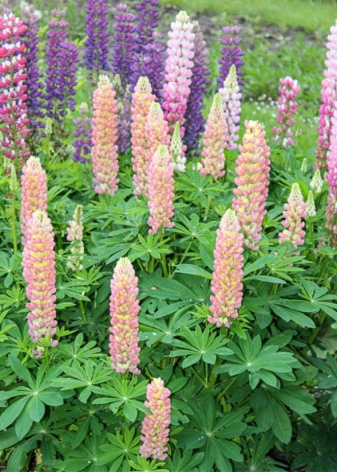
- "Tutti Frutti". Tall perennial lupine with pyramidal inflorescences. The variety grows up to 1 m, forms flowering shoots already in the year of planting.
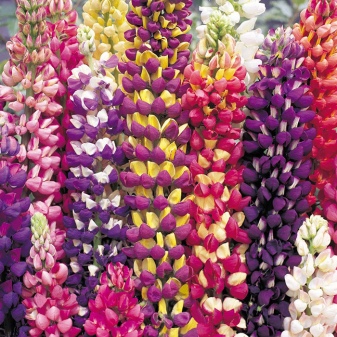

- Apricot. A juicy apricot shade of inflorescences adorns the garden from June to mid-July. This variety has very large inflorescences and excellent decorative properties. The sizes of the brushes reach 35-40 cm.


- Roseus. Perennial lupine with an original and delicate pink shade of petals. Plant height reaches 100-110 cm, of which up to 40 cm falls on large, lush pyramids of inflorescences. The budding period is short - from June to July.


- "Princess Julianne". A rare and beautiful variety with white-pink flowers. The brushes are candle-shaped and 35-40 cm long with a total stem height of 110 cm. The perennial blooms in July, decorates the garden until August.


Most of the popular hybrid varieties of perennial lupine have emerged thanks to the efforts of the British breeder Russell. In his work, he emphasized the introduction of variety in the range of colors characteristic of the petals of this plant. Today Russell's lupines are a kind of quality mark, confirming the impeccable selection work. Among the most popular are the pink-white Schlossfrau, the deep yellow Kronleuchter, the red Main Schloss, and the pure white Burg Fraulein.


How to plant?
Perennial lupins are recommended to be placed in the garden in spring, but planting in autumn is also possible, at least a month before the onset of frost. For planting in open ground, choose well-lit, sunny areas, light shading is allowed. It is necessary to thoroughly loosen and process the earth in advance. The soil should not be heavy, too dense, it is better to add additional sand and peat to it, otherwise the flowering of lupins will have to wait for a very long time. It is not recommended to plant this perennial in places with a very high level of groundwater, wetlands. Other recommendations for choosing a landing site include:
- soil type - loam or sand with a slightly alkaline or slightly acidic composition;
- good drainage, breathability and moisture permeability are very important;
- with increased acidity, lime is introduced into the soil, with alkalization - peat.




Perennial lupins must be transplanted to a new location every 3 years. It is good if earlier cereals grew on the site.
Seeds are usually sown in mid-April, then the first flowering can be expected in August. When planting in autumn, the seed is embedded in the soil until October, then left for the winter. Spring seedlings will give abundant flowering in June-July. In some cases, perennial lupins bloom only in the 2nd year. Seedling cultivation in pots and containers is possible, followed by transfer to open ground. The easiest seeding method requires a specific sequence of actions.
- In autumn, prepare the soil for the subsequent planting of plants. It can be used immediately or left until spring.
- To carry out antifungal treatment of seeds using a 50% solution of "Fundazol".
- Place the planting material in the ground with a depression of no more than 4 cm.The distance between adjacent plants should not be less than 35 cm.
- Seeds can germinate only at positive temperatures. When sowing in autumn or in sandy soil, they are deepened deeper. For the winter, the landing site is insulated with peat.


Seeds remain viable for quite a long time. For 5 years, the planting material is considered suitable for use. Algorithm of actions when growing seedlings.
- Boxes are being prepared, drainage holes are made in the bottom, ready-made flower soil is laid inside. When self-manufacturing a soil mixture, it should consist of peat and grain soil in 1 part, sand in the amount of 1/2 part.
- Sowing seeds is done in early spring. You can accelerate the germination of the culture by first scratching the leathery shell of the seeds with a needle.
- Crops are laid in the ground with a slight deepening. It is not required to immerse them very far.
- The creation of a mini greenhouse made of film or glass helps to speed up germination. Keep the container until germination in a warm and humid place.
- The first shoots should appear after a week. When the 4th leaf appears, transplanting the resulting plants into open ground is necessary. Do not delay with this, otherwise the survival rate will be low.


By following the planting rules, you can easily achieve fast forcing of healthy and strong plants and their successful subsequent cultivation in the open field.
How to take care of it properly?
When organizing the care of perennial lupines already planted, it is important to take into account all the features of this plant. He was advised to create natural or artificial shelters that protect plantings from wind and draft. You can place a tall dense shrub next to it, which allows you to eliminate the negative impact on the shoots from the outside. The plant definitely needs an abundance of sun, it affects the brightness of the color and the intensity of flowering. But the humidity of the air does not matter, the flower tolerates different climatic conditions well.


The main care for perennial lupine is based on the regular removal of weeds during the first year of life. In addition, to improve root nutrition, it is imperative to loosen the soil. As a standard, the flowering of the bush remains abundant and beautiful for 5 years. Further, its decorative properties deteriorate. Accordingly, it is necessary to update the planting precisely in the 6th year in order to achieve the most attractive appearance of a flower bed or mixborder.

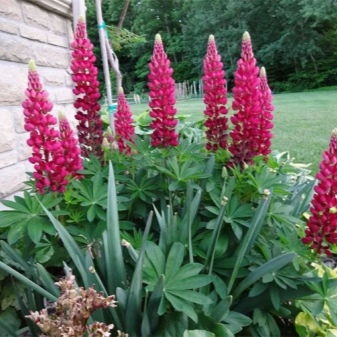
How to water?
Perennial lupins do not tolerate dampness and stagnation of moisture in the soil. When waterlogged, root rot can begin, which can lead to the death of the plant. The organization of watering must be carried out in such a way that the crop receives sufficient moisture during the first year of cultivation. During this period, intensive root growth occurs. From the second year, abundant moisture is no longer required, but during dry periods it is worth taking care of the plant additionally.


Watering in the first year after planting is carried out mainly in the evening. It is preliminarily recommended to thoroughly loosen the ground, remove weeds from it. Especially a lot of attention is paid to perennial lupine in spring, when preparing the plant for flowering. On average, in the absence of rain, watering is recommended 2 times a week.
How to fertilize?
Perennial lupine in the first year after planting does not need additional feeding. A two-year-old plant needs mineral complexes rich in phosphorus and potassium. Nitrogen is accumulated by the rhizome without outside influence, and it is not required to apply it. Top dressing is carried out annually in the spring - before the perennial lupine blooms. The plant responds well to the introduction of natural fertilizers, wood ash, organic mixtures. Dolomite flour is added to acidic soils. Correctly and in a timely manner, top dressing provides abundant flowering of perennial lupins, helps to increase their resistance to various diseases.

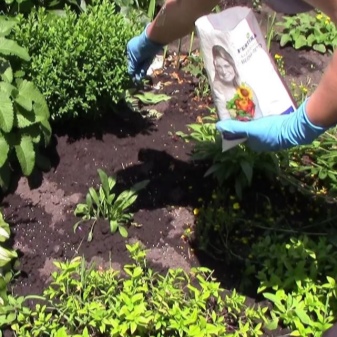
What to do after flowering?
When growing perennial lupine, it is recommended to pay great attention to caring for it during and after flowering. To make it abundant and long-lasting, it is worth regularly removing wilted inflorescences, without waiting for them to dry out and fall off themselves. This approach allows you to prolong the process of the formation of new colors. In addition, with proper care, the likelihood of a second wave of inflorescence formation in late summer or early autumn increases.
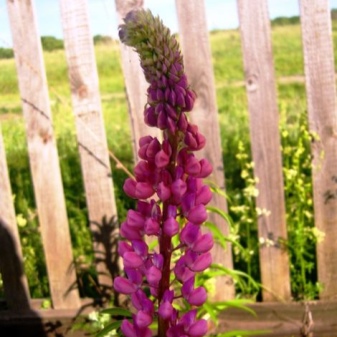

Preparing for winter is also important. After the flowering is over, you need to cut off all the leaves and inflorescences of the perennial lupine so that it does not waste energy on maintaining their viability. Additionally, on the eve of winter, it is recommended to thoroughly mulch the soil using peat or sawdust. To prevent freezing of lupine, it is imperative to monitor the condition of the root collar - it should not be exposed.


Reproduction methods
Perennial lupine propagates by seeds or vegetatively, by cuttings. It can be grown both by self-seeding and by special cultivation of seedlings. Seed can be harvested from the moment the beans turn yellowish. There is no need to wait long, after cracking the peel of the box it will be too late. The process is quite complicated, laborious and takes place in several stages.
Despite the fact that the sowing method of propagation is quite popular, when using it, it will not be possible to obtain hybrids that inherit the parental qualities of the plant. That is why true connoisseurs of perennial lupine try to reproduce by cuttings. In this case, the color of the petals will be preserved 100%, as well as varietal properties. When grafting, the procedure will be as follows.
- Choose among the plantings plants over 3 and under 6 years old.
- Select cuttings in contact with the root collar, include part of it in the cut material.
- Renewal buds at the base of the stem are cut with a knife.
- Place the prepared cuttings in a sandy substrate in a greenhouse or pot.
- Wait for the formation of an independent root system. Ready-made seedlings need to be transplanted to a permanent place.




If perennial lupine is already growing on the site, but only hybrid varieties are present, it is worth using cuttings as a propagation method.
Diseases and pests
Among the pests threatening perennial lupine can be noted affecting young seedlings and seeds.
- May beetle larvae. Thick, coiled, ring-shaped whitish caterpillars feed on roots, spoil young seedlings, destroying them in a short time.
- Weevils. These pest beetles leave very voracious larvae that mine leaves, buds, petioles, and shoots.Often, weevils appear on lupins already affected by fungal diseases.
- Wireworm. The pest affects the root system, which in lupine is a massive, well-developed stem. Its attacks can quickly disrupt the normal nutrition of the plant.


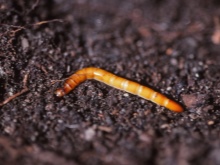
The main danger of insect pests from this group is during the growing season of the plant, in spring. In this case, there is only one method of struggle - soil treatment, which makes it possible to eliminate development conditions favorable for parasites. For perennial lupine in adulthood, such insects are dangerous.
- Aphid. A pest whose entire colonies can become a serious problem for the garden. In lupins, it affects the skin, sucks out juices, and leads to the appearance of chlorosis. Fungal cultures are actively proliferating on the affected tissues.
- Firefighter. It affects the leaves, when caterpillars appear, they curl, pests can eat pods with seeds and even flower petals.
- Thrips. Small insects feeding on plant juices can gradually lead to the death of perennial lupine. Thrips are quite difficult to get rid of.


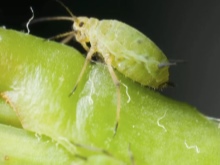
Among the diseases that affect plant organs, the most dangerous are rust, root rot, fusarium. These are infectious diseases that easily affect large populations of varietal lupins. In addition, they are not protected from viruses - a mosaic that causes mutations, and other sources of danger. The main way to deal with infections is soil reclamation followed by the introduction of lime, the treatment of plants with fungicides, if the shoots are severely damaged, they are pruned at the root.

Use in landscape design
In landscape design, it is recommended to use perennial lupine in group plantings - in a combination of different varieties of the same species or in combination with other plants. Landings with different heights look spectacular. The plant looks harmonious in mixborders and in flower beds. Multicolored perennials are very well combined with bright delphiniums, phloxes.

The proximity of perennial lupine with hosts, irises, astilbe will be successful. When planted next to fruit trees and shrubs, the plant acts as an additional supplier of nitrogen, which is necessary to increase soil fertility. In a flower bed, lupins must necessarily occupy a central place, creating a unique decorative effect.

Bringing species landscapes to life, you can use tall varieties as a backdrop for other crops. In addition, dwarf and undersized options are well suited for border plantings along low fences, hedges, and gazebos.

For information on how to properly care for perennial lupine, see the next video.



































































































The comment was sent successfully.